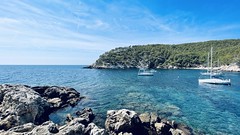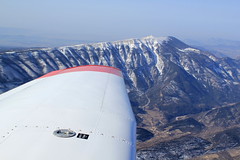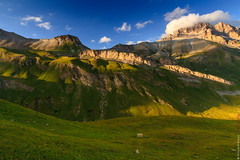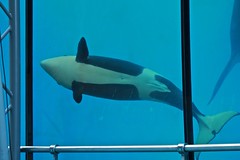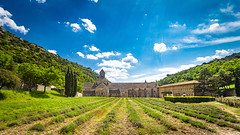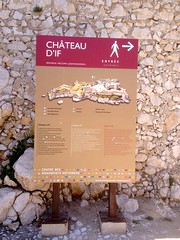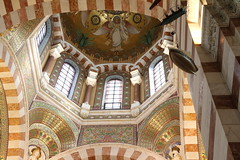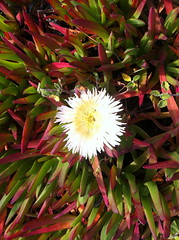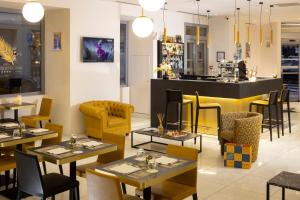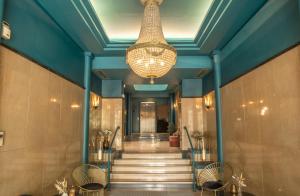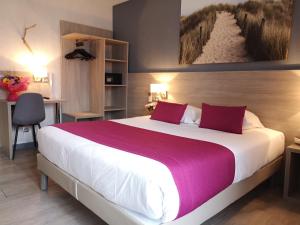Provence-Alpes-Côte d'Azur
Provence-Alpes-Côte d'Azur (French: [pʁɔvɑ̃s alp kot dazyʁ]; Occitan: Provença-Aups-Còsta d'Azur Occitan: [pɾuˈvɛnsɔ ˈawps ˈkɔstɔ daˈzyɾ] or Occitan: [pɾuˈvɛnsɔ ˈalps ˈkɔstɔ daˈzyɾ]; commonly shortened to PACA; English: Provence-Alps-French Riviera), also known as Région Sud (Southern Region), is one of the eighteen administrative regions of France, the far southeastern on the mainland. Its prefecture and largest city is Marseille.
History
The region is roughly coterminous with the former French province of Provence, with the addition of the following adjacent areas: the former papal territory of Avignon, known as Comtat Venaissin; the former Sardinian-Piedmontese County of Nice annexed in 1860, whose coastline is known in English as the French Riviera and in French as the Côte d'Azur; and the southeastern part of the former French province of Dauphiné, in the French Alps. Previously known by the acronym PACA, the region adopted the name Région Sud as a commercial name or nickname in December 2017.
Geography
It encompasses six departments in Southeastern France: Alpes-de-Haute-Provence, Alpes-Maritimes, Bouches-du-Rhône, Hautes-Alpes, Var and Vaucluse. It is bounded to the east by the France–Italy border, to the south by the Mediterranean Sea and by the Principality of Monaco, to the north by Auvergne-Rhône-Alpes and to the west by Occitanie, with the Rhône marking its westernmost border. 5,007,977 people live in the region according to the 2015 census.
Symbols
The region logotype displays the coat of arms created in the 1990s and which combines the coats of arms of the old provinces making up Provence-Alpes-Côte d'Azur. The region's economy is the third largest in France, just behind Île-de-France and Auvergne-Rhône-Alpes. Its GDP in 2015 was €168.2 billion (US$190.5 billion) while its per capita GDP was €30,863 (US$34,950).
Demographics
Population
As of 2018, the population of the region was 5,052,832; Marseille and its metropolitan area is the most populous in the region with a city population of 868,277, an urban population of 1,607,292 and a metropolitan population of 1,863,762. Marseille is the second largest city in France after Paris, and has the third largest metropolitan population, behind those of Paris and Lyon respectively.
Nice is host to the second-largest population concentration in the region, with a city population of 344,875 and an urban population of 1,005,230, making it the fifth-most populous city in France.
Languages
The absolute majority of the population speaks French but many regional and foreign languages are present in the region.
The 1999 Census, which included a complementary survey asking for the mother tongue of the respondents, gave results on the most spoken mother tongues in Provence after French:
- Provençal 5.2%
- Italian 4.4%
- Arabic 3.0%
- Spanish 2.8%
- Corsican 1.1%
Immigration
According to a 2009 study, nearly 40% of all newborns in Provence-Alpes-Côte d'Azur in 2007 had at least one parent of an immigrant background, mostly Italian, Spanish, Portuguese and Maghrebi. This is the second-highest rate after Île-de-France (Greater Paris), where the figure was around 56%. Since the 1960s, the region has been a major immigration centre from France and into France, mostly due to Northern French and to Mediterranean immigration from countries such as Portugal, Spain, Italy, Algeria, Tunisia and Morocco.
Departments
Provence-Alpes-Côte d'Azur is divided into 6 departments. These are Alpes-de-Haute-Provence, Hautes-Alpes, Alpes-Maritimes, Bouches-du-Rhône, Var and Vaucluse.
| Department | Area | Population | Prefecture | Sub-prefecture(s) | Population density | |
|---|---|---|---|---|---|---|
| 04 | Alpes-de-Haute-Provence | Digne-les-Bains | Barcelonnette, Castellane and Forcalquier | |||
| 05 | Hautes-Alpes | Gap | Briançon | |||
| 06 | Alpes-Maritimes | Nice | Grasse | |||
| 13 | Bouches-du-Rhône | Marseille | Aix-en-Provence, Arles and Istres | |||
| 83 | Var | Toulon | Brignoles and Draguignan | |||
| 84 | Vaucluse | Avignon | Apt and Carpentras | |||
Major cities
The largest cities in the region are Marseille (regional prefecture), Nice, Toulon and Aix-en-Provence, each with a population exceeding 100,000 inhabitants at the 1999 census. After Marseille, Nice is the second most populous city in the region, with a city proper population of about 350,000 and an urban population exceeding 1 million.
Marseille has an urban area of 2 million inhabitants and is the largest and capital city of Provence-Alpes-Côte d'Azur region. It is also the second-most populated city in France, just behind Paris, and the city with the third-largest metropolitan population in France, behind Paris and Lyon, respectively.
Along with Nice and Marseille, the region is also made internationally popular with Cannes, a city that, despite its comparatively small size (population of 73,603 in 2012), hosts the annual Cannes Film Festival, which has highly popularized the region. In addition, Arles has become renowned as the city where Vincent van Gogh lived and painted 300 paintings.
Toulon is a large military harbour on the Mediterranean coast and is home to a French naval base. It is the capital of the Var department in the region. Also, Aix-en-Provence has long been a university town and, to this day, remains the most important educational centre in the region.
Below is a list of the most populated cities in the region along with their population (city proper) according to the most recent census:
- Aix-en-Provence – 142,743
- Antibes (includes Juan-les-Pins) – 76,994
- Arles – 52,729
- Aubagne – 46,423
- Avignon – 90,194
- Cannes – 73,603
- Draguignan – 38,258
- Fréjus – 52,389
- Grasse – 51,580
- Hyères – 56,275
- La Seyne-sur-Mer – 64,903
- Le Cannet – 40,940
- Mandelieu-la-Napoule – 22,714
- Manosque – 22,333
- Marseille – 861,636
- Martigues – 76,471
- Mougins – 19,703
- Nice – 343,875
- Salon-de-Provence – 45,400
- Toulon – 167,729
- Villeneuve-Loubet – 14,427
Geography
This region has a total area of . It has a wide variety of landscapes, from the Alps mountains to plains and coastal areas like Nice and Marseille, which form the majority of the land area. The region has a Mediterranean coastline on the south, on which the majority of its population lives. It borders Italy (Liguria and Piedmont) to the east, Monaco (Fontvieille, La Colle, La Rousse, Larvotto, Les Moneghetti, Les Révoires, Saint Michel) in the south-east, and the French regions of Auvergne-Rhone-Alpes to the north and Occitanie to the west. The Rhône, Durance, Var and Arc rivers run through the region. The borders were unaffected by the 2016 French regional reforms.
This region is famous for the Côte d'Azur (French Riviera), which spans the coastal cities of Nice, Saint-Laurent-du-Var, Antibes, Juan-les-Pins, Cannes, Mandelieu-la-Napoule, Fréjus, Saint-Raphaël, Sainte-Maxime and Saint-Tropez; and on the Rhône river, the city of Avignon which is surrounded by medieval stone walls.
Presidential election results
In the second round of the last four presidential elections, Provence-Alpes-Côte d'Azur voted as follows, with the winner of the election indicated in italics:
| Election | Regional winner | Regional runner-up |
|---|---|---|
| 2022 | Marine Le Pen (50.5%) | Emmanuel Macron (49.5%) |
| 2017 | Emmanuel Macron (55.5%) | Marine Le Pen (45.5%) |
| 2012 | Nicolas Sarkozy (57.6%) | François Hollande (42.4%) |
| 2007 | Nicolas Sarkozy (61.8%) | Ségolène Royal (38.2%) |
| 2002 | Jacques Chirac (72.3%) | Jean-Marie Le Pen (27.7%) |
Culture
The region is one of the most visited of France, and has therefore many well-known museums, mostly in Marseille: the Museum of European and Mediterranean Civilisations, the Musée Cantini, the Musée Grobet-Labadié, the Marseille History Museum, the Musée des beaux-arts de Marseille, the Musée de la Faïence de Marseille and the Muséum d'histoire naturelle de Marseille are some of the tourist spots of the city. However, other museums are internationally recognised, like the Musée Matisse, the Musée d'art moderne et d'art contemporain, the Musée Marc Chagall, the Musée international d'Art naïf Anatole Jakovsky, the Musée des Beaux-Arts de Nice, the Musée National du Sport and the Muséum d'histoire naturelle de Nice.
Environment
The mining company Alteo processes bauxite to produce aluminium, resulting in various waste materials such as "boues rouges" (red mud) and arsenic. The dumping of this waste in the marine reserve of Calanques National Park for six years was authorised by the French Government in 2015. Company representatives have dismissed environmental concerns as exaggerated and uninformed. The region also includes another national park, Port-Cros National Park near Toulon.
Due to motor vehicle traffic, the urban areas are often saturated on a daily basis, but cities are investing in public transport networks such as Marseille's subway (2 lines) and tramway (3 lines), the Aubagne tramway (1 line) and the Nice tramway (3 lines). Other networks existed at the beginning of the 20th century in smaller cities such as Aix-en-Provence, Avignon, La Ciotat and Toulon but are now gone.
External links
- Discover all the regions of France- Official French tourism website (in English) – separate entries for Côte d'Azur and Provence
- Conseil régional Provence-Alpes-Côte d'Azur Official website of the regional council
- Provenceweb.fr Provence-Alpes-Côte d'Azur Guide
Hotels Provence-Alpes-Côte d'Azur
Looking for places related to Provence-Alpes-Côte d'Azur?
Those are other destinations to find places related to Provence-Alpes-Côte d'Azur:

